Applying Critical Thinking: Comprehensive Analysis of Audrey's Case
VerifiedAdded on 2023/06/11
|17
|4520
|392
Case Study
AI Summary
This case study delves into the application of critical thinking in managing the complex healthcare needs of a patient named Audrey. Audrey presents with multiple chronic conditions including atrial fibrillation, hypertension, a history of stroke, GORD, osteoporosis, depression, and type 2 diabetes. Th...
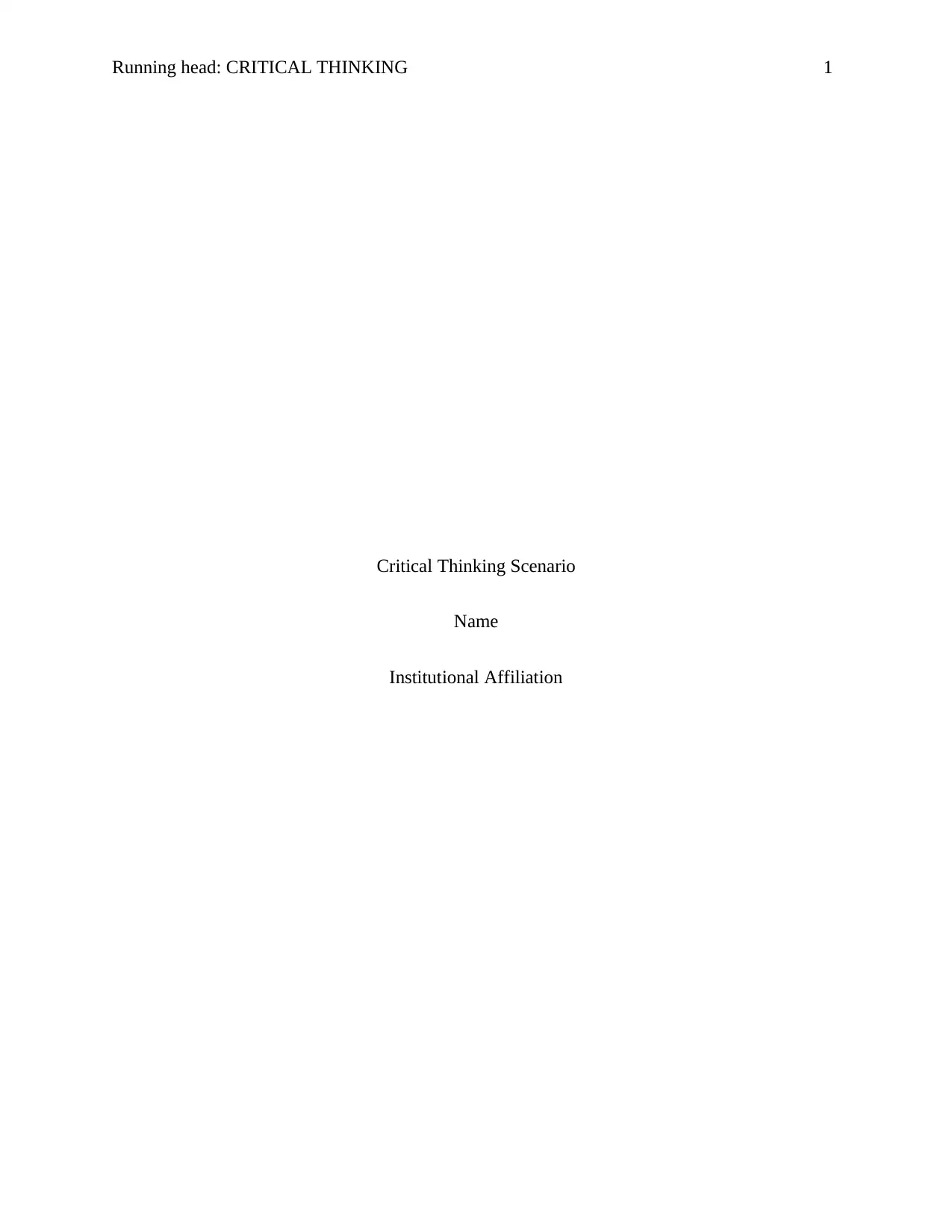
Running head: CRITICAL THINKING 1
Critical Thinking Scenario
Name
Institutional Affiliation
Critical Thinking Scenario
Name
Institutional Affiliation
Paraphrase This Document
Need a fresh take? Get an instant paraphrase of this document with our AI Paraphraser
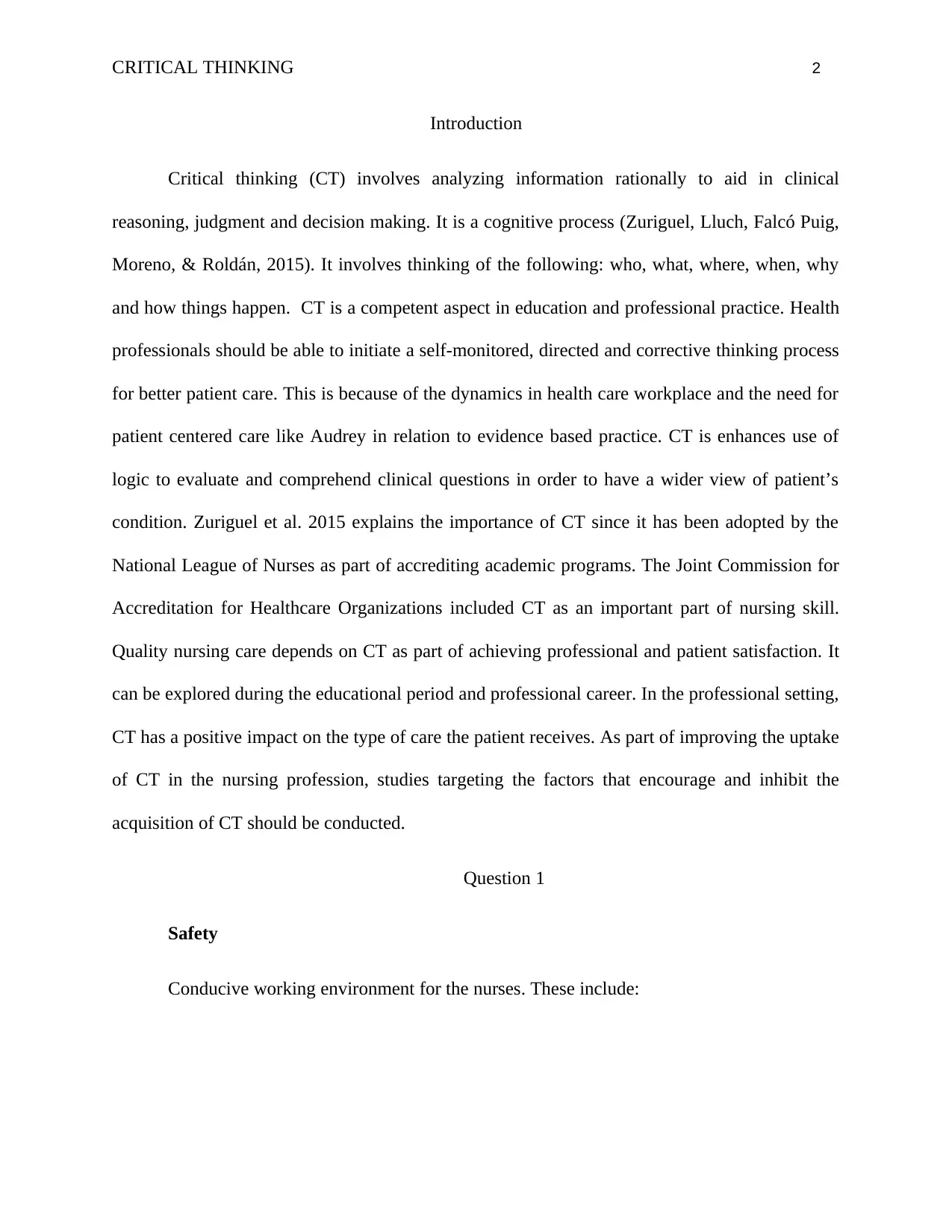
CRITICAL THINKING 2
Introduction
Critical thinking (CT) involves analyzing information rationally to aid in clinical
reasoning, judgment and decision making. It is a cognitive process (Zuriguel, Lluch, Falcó Puig,
Moreno, & Roldán, 2015). It involves thinking of the following: who, what, where, when, why
and how things happen. CT is a competent aspect in education and professional practice. Health
professionals should be able to initiate a self-monitored, directed and corrective thinking process
for better patient care. This is because of the dynamics in health care workplace and the need for
patient centered care like Audrey in relation to evidence based practice. CT is enhances use of
logic to evaluate and comprehend clinical questions in order to have a wider view of patient’s
condition. Zuriguel et al. 2015 explains the importance of CT since it has been adopted by the
National League of Nurses as part of accrediting academic programs. The Joint Commission for
Accreditation for Healthcare Organizations included CT as an important part of nursing skill.
Quality nursing care depends on CT as part of achieving professional and patient satisfaction. It
can be explored during the educational period and professional career. In the professional setting,
CT has a positive impact on the type of care the patient receives. As part of improving the uptake
of CT in the nursing profession, studies targeting the factors that encourage and inhibit the
acquisition of CT should be conducted.
Question 1
Safety
Conducive working environment for the nurses. These include:
Introduction
Critical thinking (CT) involves analyzing information rationally to aid in clinical
reasoning, judgment and decision making. It is a cognitive process (Zuriguel, Lluch, Falcó Puig,
Moreno, & Roldán, 2015). It involves thinking of the following: who, what, where, when, why
and how things happen. CT is a competent aspect in education and professional practice. Health
professionals should be able to initiate a self-monitored, directed and corrective thinking process
for better patient care. This is because of the dynamics in health care workplace and the need for
patient centered care like Audrey in relation to evidence based practice. CT is enhances use of
logic to evaluate and comprehend clinical questions in order to have a wider view of patient’s
condition. Zuriguel et al. 2015 explains the importance of CT since it has been adopted by the
National League of Nurses as part of accrediting academic programs. The Joint Commission for
Accreditation for Healthcare Organizations included CT as an important part of nursing skill.
Quality nursing care depends on CT as part of achieving professional and patient satisfaction. It
can be explored during the educational period and professional career. In the professional setting,
CT has a positive impact on the type of care the patient receives. As part of improving the uptake
of CT in the nursing profession, studies targeting the factors that encourage and inhibit the
acquisition of CT should be conducted.
Question 1
Safety
Conducive working environment for the nurses. These include:
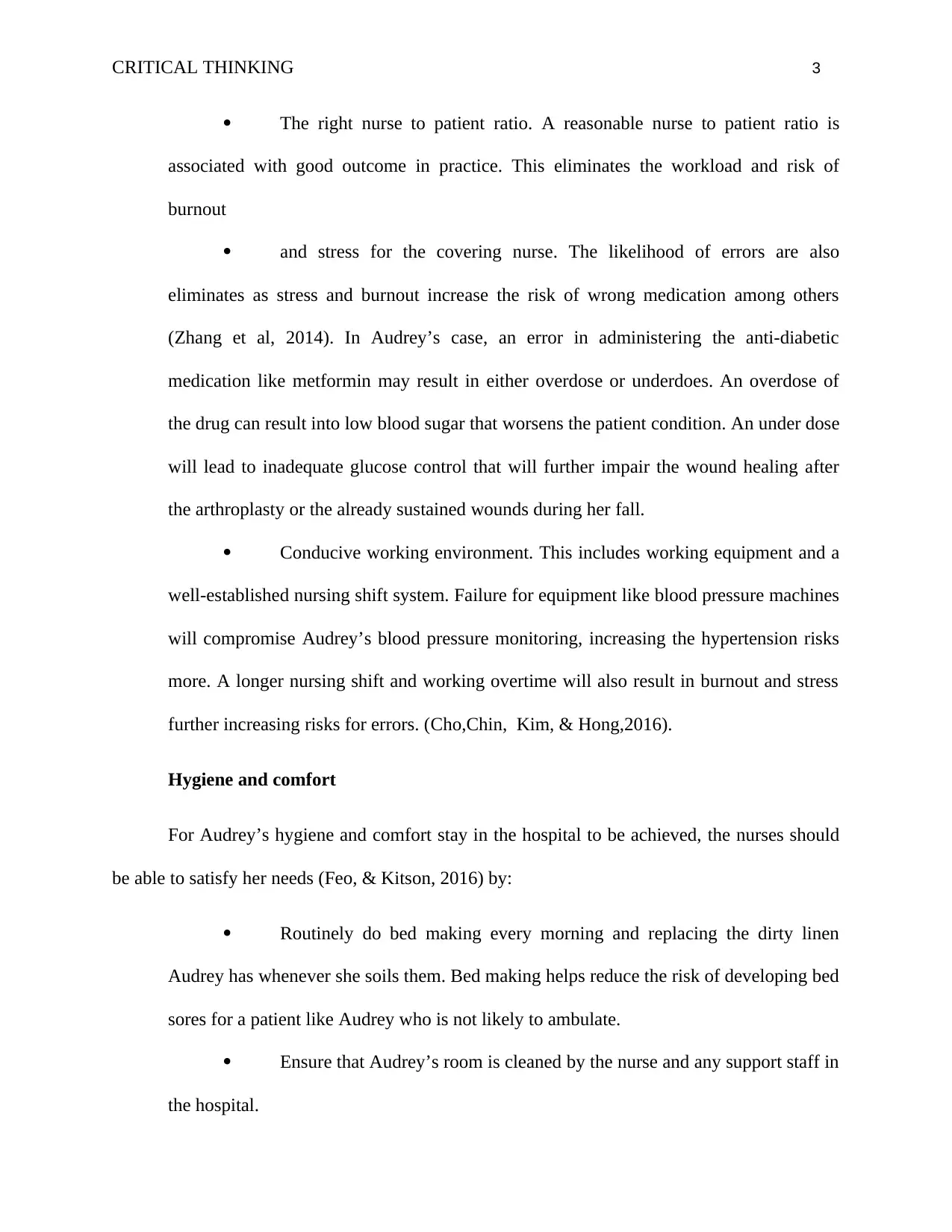
CRITICAL THINKING 3
The right nurse to patient ratio. A reasonable nurse to patient ratio is
associated with good outcome in practice. This eliminates the workload and risk of
burnout
and stress for the covering nurse. The likelihood of errors are also
eliminates as stress and burnout increase the risk of wrong medication among others
(Zhang et al, 2014). In Audrey’s case, an error in administering the anti-diabetic
medication like metformin may result in either overdose or underdoes. An overdose of
the drug can result into low blood sugar that worsens the patient condition. An under dose
will lead to inadequate glucose control that will further impair the wound healing after
the arthroplasty or the already sustained wounds during her fall.
Conducive working environment. This includes working equipment and a
well-established nursing shift system. Failure for equipment like blood pressure machines
will compromise Audrey’s blood pressure monitoring, increasing the hypertension risks
more. A longer nursing shift and working overtime will also result in burnout and stress
further increasing risks for errors. (Cho,Chin, Kim, & Hong,2016).
Hygiene and comfort
For Audrey’s hygiene and comfort stay in the hospital to be achieved, the nurses should
be able to satisfy her needs (Feo, & Kitson, 2016) by:
Routinely do bed making every morning and replacing the dirty linen
Audrey has whenever she soils them. Bed making helps reduce the risk of developing bed
sores for a patient like Audrey who is not likely to ambulate.
Ensure that Audrey’s room is cleaned by the nurse and any support staff in
the hospital.
The right nurse to patient ratio. A reasonable nurse to patient ratio is
associated with good outcome in practice. This eliminates the workload and risk of
burnout
and stress for the covering nurse. The likelihood of errors are also
eliminates as stress and burnout increase the risk of wrong medication among others
(Zhang et al, 2014). In Audrey’s case, an error in administering the anti-diabetic
medication like metformin may result in either overdose or underdoes. An overdose of
the drug can result into low blood sugar that worsens the patient condition. An under dose
will lead to inadequate glucose control that will further impair the wound healing after
the arthroplasty or the already sustained wounds during her fall.
Conducive working environment. This includes working equipment and a
well-established nursing shift system. Failure for equipment like blood pressure machines
will compromise Audrey’s blood pressure monitoring, increasing the hypertension risks
more. A longer nursing shift and working overtime will also result in burnout and stress
further increasing risks for errors. (Cho,Chin, Kim, & Hong,2016).
Hygiene and comfort
For Audrey’s hygiene and comfort stay in the hospital to be achieved, the nurses should
be able to satisfy her needs (Feo, & Kitson, 2016) by:
Routinely do bed making every morning and replacing the dirty linen
Audrey has whenever she soils them. Bed making helps reduce the risk of developing bed
sores for a patient like Audrey who is not likely to ambulate.
Ensure that Audrey’s room is cleaned by the nurse and any support staff in
the hospital.
⊘ This is a preview!⊘
Do you want full access?
Subscribe today to unlock all pages.

Trusted by 1+ million students worldwide
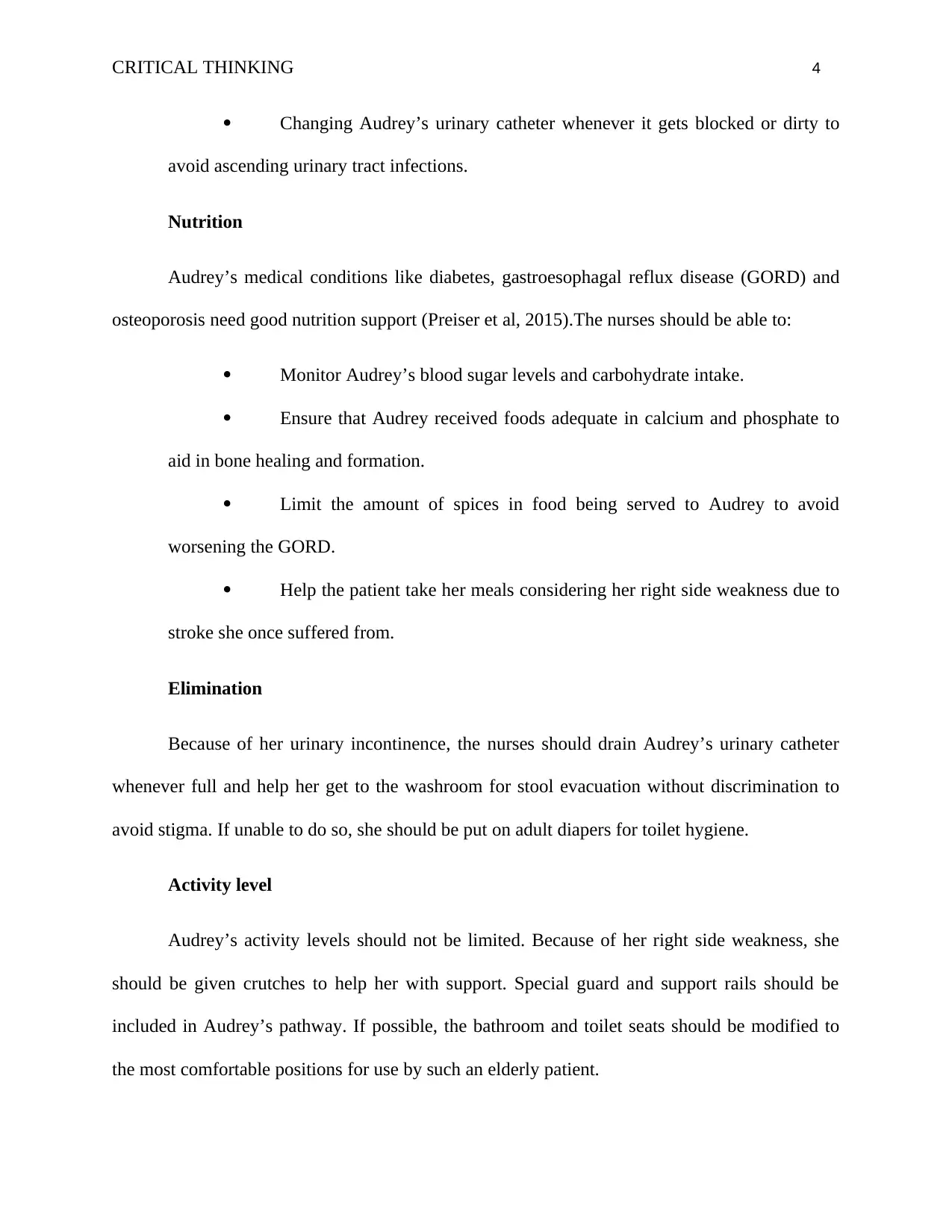
CRITICAL THINKING 4
Changing Audrey’s urinary catheter whenever it gets blocked or dirty to
avoid ascending urinary tract infections.
Nutrition
Audrey’s medical conditions like diabetes, gastroesophagal reflux disease (GORD) and
osteoporosis need good nutrition support (Preiser et al, 2015).The nurses should be able to:
Monitor Audrey’s blood sugar levels and carbohydrate intake.
Ensure that Audrey received foods adequate in calcium and phosphate to
aid in bone healing and formation.
Limit the amount of spices in food being served to Audrey to avoid
worsening the GORD.
Help the patient take her meals considering her right side weakness due to
stroke she once suffered from.
Elimination
Because of her urinary incontinence, the nurses should drain Audrey’s urinary catheter
whenever full and help her get to the washroom for stool evacuation without discrimination to
avoid stigma. If unable to do so, she should be put on adult diapers for toilet hygiene.
Activity level
Audrey’s activity levels should not be limited. Because of her right side weakness, she
should be given crutches to help her with support. Special guard and support rails should be
included in Audrey’s pathway. If possible, the bathroom and toilet seats should be modified to
the most comfortable positions for use by such an elderly patient.
Changing Audrey’s urinary catheter whenever it gets blocked or dirty to
avoid ascending urinary tract infections.
Nutrition
Audrey’s medical conditions like diabetes, gastroesophagal reflux disease (GORD) and
osteoporosis need good nutrition support (Preiser et al, 2015).The nurses should be able to:
Monitor Audrey’s blood sugar levels and carbohydrate intake.
Ensure that Audrey received foods adequate in calcium and phosphate to
aid in bone healing and formation.
Limit the amount of spices in food being served to Audrey to avoid
worsening the GORD.
Help the patient take her meals considering her right side weakness due to
stroke she once suffered from.
Elimination
Because of her urinary incontinence, the nurses should drain Audrey’s urinary catheter
whenever full and help her get to the washroom for stool evacuation without discrimination to
avoid stigma. If unable to do so, she should be put on adult diapers for toilet hygiene.
Activity level
Audrey’s activity levels should not be limited. Because of her right side weakness, she
should be given crutches to help her with support. Special guard and support rails should be
included in Audrey’s pathway. If possible, the bathroom and toilet seats should be modified to
the most comfortable positions for use by such an elderly patient.
Paraphrase This Document
Need a fresh take? Get an instant paraphrase of this document with our AI Paraphraser
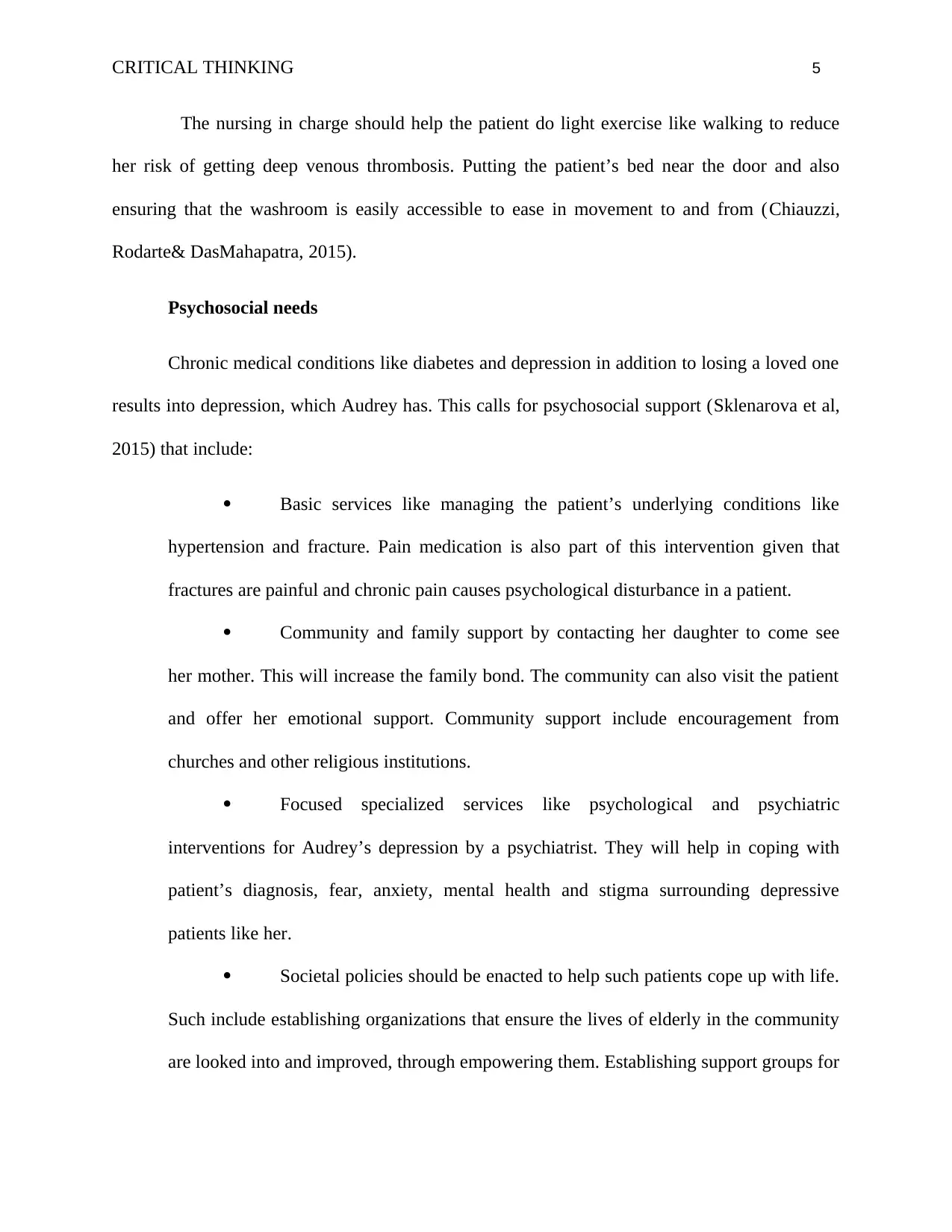
CRITICAL THINKING 5
The nursing in charge should help the patient do light exercise like walking to reduce
her risk of getting deep venous thrombosis. Putting the patient’s bed near the door and also
ensuring that the washroom is easily accessible to ease in movement to and from (Chiauzzi,
Rodarte& DasMahapatra, 2015).
Psychosocial needs
Chronic medical conditions like diabetes and depression in addition to losing a loved one
results into depression, which Audrey has. This calls for psychosocial support (Sklenarova et al,
2015) that include:
Basic services like managing the patient’s underlying conditions like
hypertension and fracture. Pain medication is also part of this intervention given that
fractures are painful and chronic pain causes psychological disturbance in a patient.
Community and family support by contacting her daughter to come see
her mother. This will increase the family bond. The community can also visit the patient
and offer her emotional support. Community support include encouragement from
churches and other religious institutions.
Focused specialized services like psychological and psychiatric
interventions for Audrey’s depression by a psychiatrist. They will help in coping with
patient’s diagnosis, fear, anxiety, mental health and stigma surrounding depressive
patients like her.
Societal policies should be enacted to help such patients cope up with life.
Such include establishing organizations that ensure the lives of elderly in the community
are looked into and improved, through empowering them. Establishing support groups for
The nursing in charge should help the patient do light exercise like walking to reduce
her risk of getting deep venous thrombosis. Putting the patient’s bed near the door and also
ensuring that the washroom is easily accessible to ease in movement to and from (Chiauzzi,
Rodarte& DasMahapatra, 2015).
Psychosocial needs
Chronic medical conditions like diabetes and depression in addition to losing a loved one
results into depression, which Audrey has. This calls for psychosocial support (Sklenarova et al,
2015) that include:
Basic services like managing the patient’s underlying conditions like
hypertension and fracture. Pain medication is also part of this intervention given that
fractures are painful and chronic pain causes psychological disturbance in a patient.
Community and family support by contacting her daughter to come see
her mother. This will increase the family bond. The community can also visit the patient
and offer her emotional support. Community support include encouragement from
churches and other religious institutions.
Focused specialized services like psychological and psychiatric
interventions for Audrey’s depression by a psychiatrist. They will help in coping with
patient’s diagnosis, fear, anxiety, mental health and stigma surrounding depressive
patients like her.
Societal policies should be enacted to help such patients cope up with life.
Such include establishing organizations that ensure the lives of elderly in the community
are looked into and improved, through empowering them. Establishing support groups for

CRITICAL THINKING 6
disabled people like Audrey by giving out crutches and wheel chair, improving the
ergonomics around their work and living conditions.
Question 2
Mrs. Smiths’ diagnoses are tied and need specialized interventions.
Atrial fibrillation
Atrial fibrillation results when the heart rapidly beat in an unsynchronized manner. It is
likely that Audrey developed AF due to smoking and drinking alcohol, in addition to
hypertension that is also a risk factor. The nursing team should be aware of the possible
development of clots and likelihood to dislodge thus put Audrey on prophylactic anticoagulant.
Hypertension
Hypertension results when the heart is overworking to pump blood to satisfy body’s
needs. Uncontrolled type 2 diabetes, smoking and social drinking are risk factors for developing
hypertension (Bernabé-Ortiz et al, 2016). The nurse should monitor Audrey’s blood pressure
regularly and ensure she takes her hypertension medication.
Left CVA
Uncontrolled hypertension, diabetes and atrial fibrillation as in Audrey’s case are also
risk factors for developing a stroke (O'Donnell et al, 2016).The stroke may have resulted in right
sided weakness that is a trigger for the fall, in addition to dizziness that is a side effect of
Mylanta. The nursing team should help Audrey with movement and help her taker her food and
medication.
disabled people like Audrey by giving out crutches and wheel chair, improving the
ergonomics around their work and living conditions.
Question 2
Mrs. Smiths’ diagnoses are tied and need specialized interventions.
Atrial fibrillation
Atrial fibrillation results when the heart rapidly beat in an unsynchronized manner. It is
likely that Audrey developed AF due to smoking and drinking alcohol, in addition to
hypertension that is also a risk factor. The nursing team should be aware of the possible
development of clots and likelihood to dislodge thus put Audrey on prophylactic anticoagulant.
Hypertension
Hypertension results when the heart is overworking to pump blood to satisfy body’s
needs. Uncontrolled type 2 diabetes, smoking and social drinking are risk factors for developing
hypertension (Bernabé-Ortiz et al, 2016). The nurse should monitor Audrey’s blood pressure
regularly and ensure she takes her hypertension medication.
Left CVA
Uncontrolled hypertension, diabetes and atrial fibrillation as in Audrey’s case are also
risk factors for developing a stroke (O'Donnell et al, 2016).The stroke may have resulted in right
sided weakness that is a trigger for the fall, in addition to dizziness that is a side effect of
Mylanta. The nursing team should help Audrey with movement and help her taker her food and
medication.
⊘ This is a preview!⊘
Do you want full access?
Subscribe today to unlock all pages.

Trusted by 1+ million students worldwide

CRITICAL THINKING 7
GORD
Smoking and alcohol increase the chances to get GORD (KUMAR, Gandhi & Harsha,
2016). GORD occurs when there is weakness of the lower esophageal sphincter allowing the
acid from stomach corrode the esophagus. The nursing team should ensure Audrey take her
drugs for relief and watch out for complications.
Osteoporosis
Osteoporosis occurs when the bones become week and fragile due to a number of
reasons. Because of Audrey’s advanced aged, the protective effects of estrogen for the bones are
absent, thus resulting to weak bones which further increases her susceptibility for fracture of the
left shoulder (Ahn,Lee, Park, Noh & Kim, 2015).
Depression
Losing a loved one like Audrey’s husband and hysterectomy may have contributed to her
depression (Mehra, 2014). The nursing team should ensure Audrey take her medication for the
depression and referring to a psychiatrist if symptoms persist.
Type 2 Diabetes Mellitus
Type 2 diabetes mellitus results when the body cannot control the blood sugar levels
because of relative lack of insulin ((Bernabé-Ortiz et al, 2016). The blood sugar and pressure
levels must be closely monitored by the nursing team.
GORD
Smoking and alcohol increase the chances to get GORD (KUMAR, Gandhi & Harsha,
2016). GORD occurs when there is weakness of the lower esophageal sphincter allowing the
acid from stomach corrode the esophagus. The nursing team should ensure Audrey take her
drugs for relief and watch out for complications.
Osteoporosis
Osteoporosis occurs when the bones become week and fragile due to a number of
reasons. Because of Audrey’s advanced aged, the protective effects of estrogen for the bones are
absent, thus resulting to weak bones which further increases her susceptibility for fracture of the
left shoulder (Ahn,Lee, Park, Noh & Kim, 2015).
Depression
Losing a loved one like Audrey’s husband and hysterectomy may have contributed to her
depression (Mehra, 2014). The nursing team should ensure Audrey take her medication for the
depression and referring to a psychiatrist if symptoms persist.
Type 2 Diabetes Mellitus
Type 2 diabetes mellitus results when the body cannot control the blood sugar levels
because of relative lack of insulin ((Bernabé-Ortiz et al, 2016). The blood sugar and pressure
levels must be closely monitored by the nursing team.
Paraphrase This Document
Need a fresh take? Get an instant paraphrase of this document with our AI Paraphraser
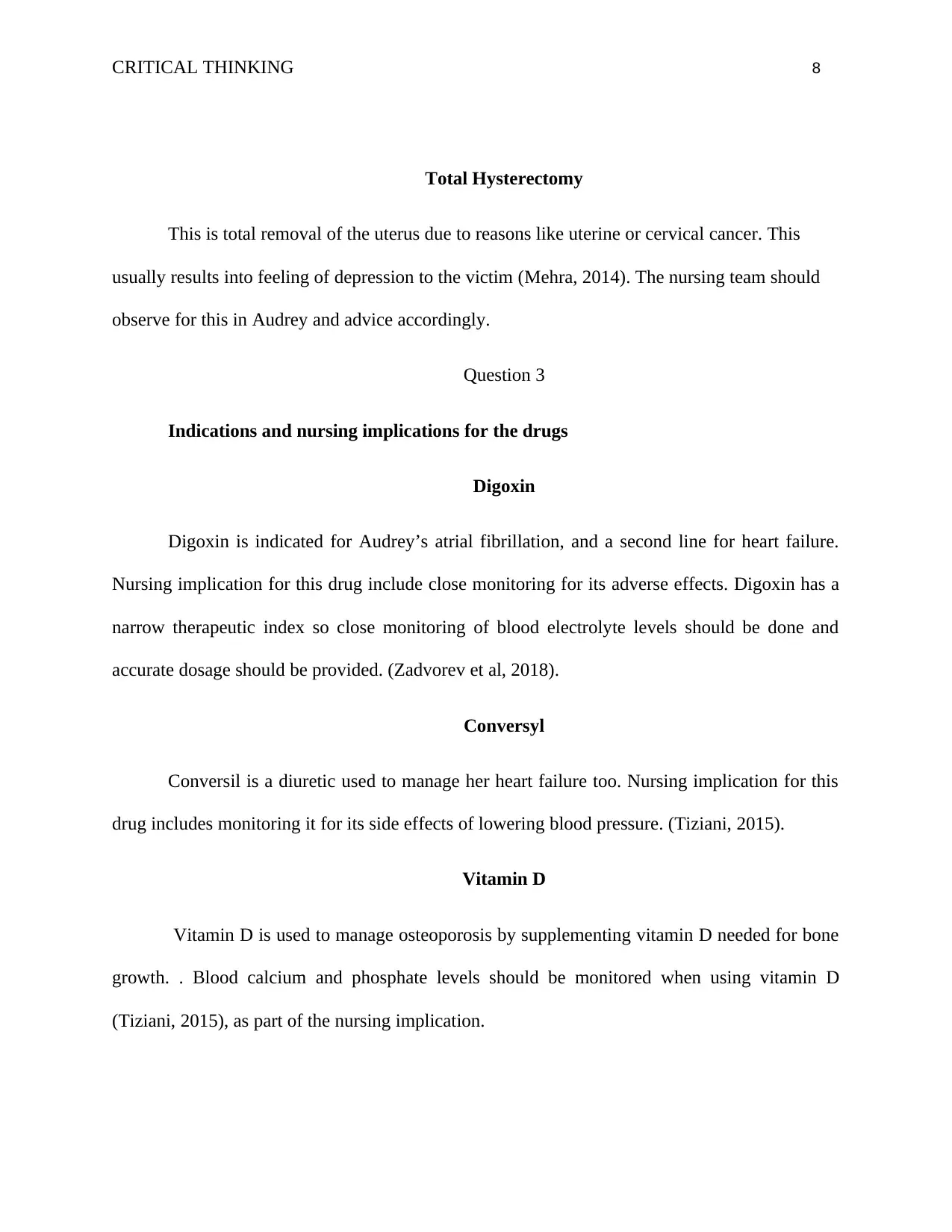
CRITICAL THINKING 8
Total Hysterectomy
This is total removal of the uterus due to reasons like uterine or cervical cancer. This
usually results into feeling of depression to the victim (Mehra, 2014). The nursing team should
observe for this in Audrey and advice accordingly.
Question 3
Indications and nursing implications for the drugs
Digoxin
Digoxin is indicated for Audrey’s atrial fibrillation, and a second line for heart failure.
Nursing implication for this drug include close monitoring for its adverse effects. Digoxin has a
narrow therapeutic index so close monitoring of blood electrolyte levels should be done and
accurate dosage should be provided. (Zadvorev et al, 2018).
Conversyl
Conversil is a diuretic used to manage her heart failure too. Nursing implication for this
drug includes monitoring it for its side effects of lowering blood pressure. (Tiziani, 2015).
Vitamin D
Vitamin D is used to manage osteoporosis by supplementing vitamin D needed for bone
growth. . Blood calcium and phosphate levels should be monitored when using vitamin D
(Tiziani, 2015), as part of the nursing implication.
Total Hysterectomy
This is total removal of the uterus due to reasons like uterine or cervical cancer. This
usually results into feeling of depression to the victim (Mehra, 2014). The nursing team should
observe for this in Audrey and advice accordingly.
Question 3
Indications and nursing implications for the drugs
Digoxin
Digoxin is indicated for Audrey’s atrial fibrillation, and a second line for heart failure.
Nursing implication for this drug include close monitoring for its adverse effects. Digoxin has a
narrow therapeutic index so close monitoring of blood electrolyte levels should be done and
accurate dosage should be provided. (Zadvorev et al, 2018).
Conversyl
Conversil is a diuretic used to manage her heart failure too. Nursing implication for this
drug includes monitoring it for its side effects of lowering blood pressure. (Tiziani, 2015).
Vitamin D
Vitamin D is used to manage osteoporosis by supplementing vitamin D needed for bone
growth. . Blood calcium and phosphate levels should be monitored when using vitamin D
(Tiziani, 2015), as part of the nursing implication.
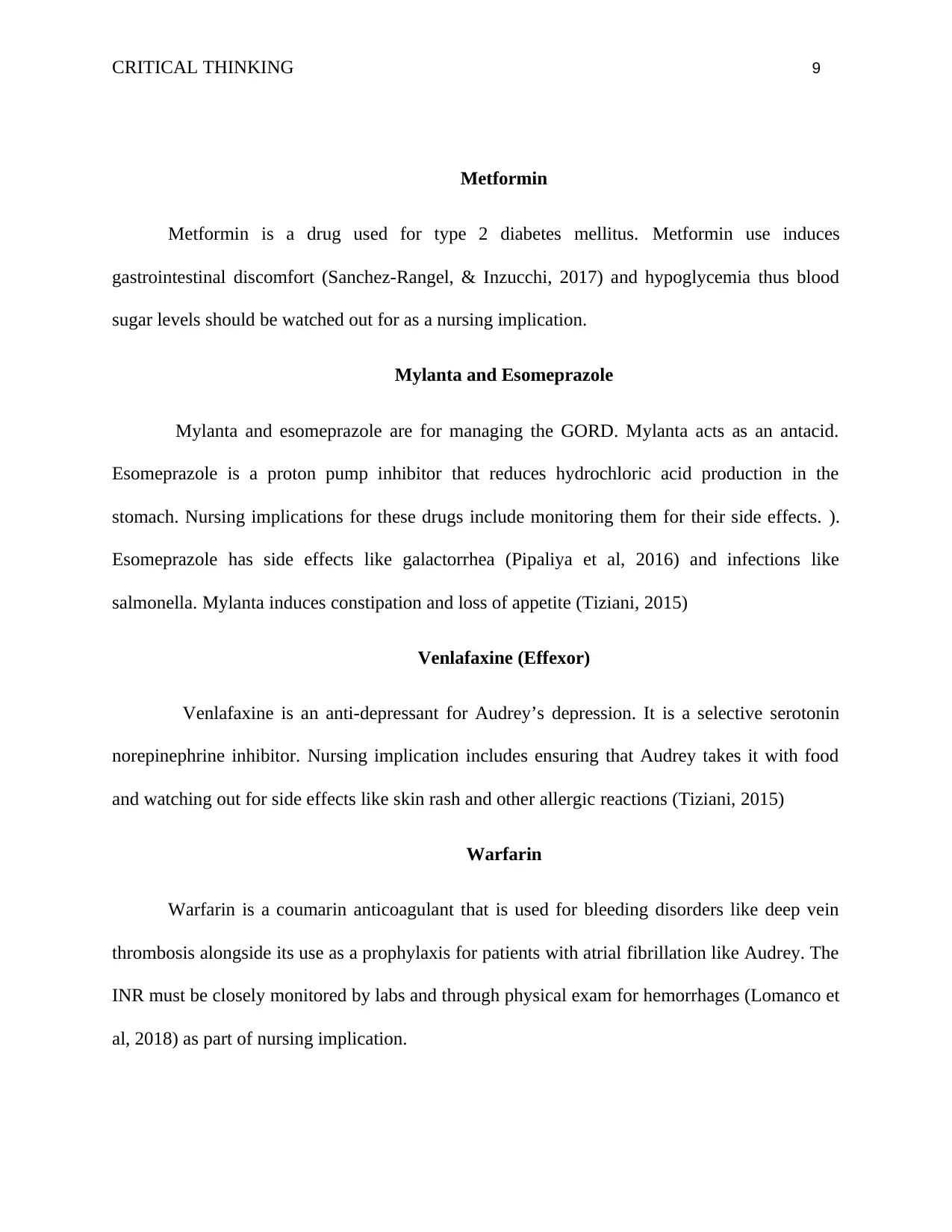
CRITICAL THINKING 9
Metformin
Metformin is a drug used for type 2 diabetes mellitus. Metformin use induces
gastrointestinal discomfort (Sanchez-Rangel, & Inzucchi, 2017) and hypoglycemia thus blood
sugar levels should be watched out for as a nursing implication.
Mylanta and Esomeprazole
Mylanta and esomeprazole are for managing the GORD. Mylanta acts as an antacid.
Esomeprazole is a proton pump inhibitor that reduces hydrochloric acid production in the
stomach. Nursing implications for these drugs include monitoring them for their side effects. ).
Esomeprazole has side effects like galactorrhea (Pipaliya et al, 2016) and infections like
salmonella. Mylanta induces constipation and loss of appetite (Tiziani, 2015)
Venlafaxine (Effexor)
Venlafaxine is an anti-depressant for Audrey’s depression. It is a selective serotonin
norepinephrine inhibitor. Nursing implication includes ensuring that Audrey takes it with food
and watching out for side effects like skin rash and other allergic reactions (Tiziani, 2015)
Warfarin
Warfarin is a coumarin anticoagulant that is used for bleeding disorders like deep vein
thrombosis alongside its use as a prophylaxis for patients with atrial fibrillation like Audrey. The
INR must be closely monitored by labs and through physical exam for hemorrhages (Lomanco et
al, 2018) as part of nursing implication.
Metformin
Metformin is a drug used for type 2 diabetes mellitus. Metformin use induces
gastrointestinal discomfort (Sanchez-Rangel, & Inzucchi, 2017) and hypoglycemia thus blood
sugar levels should be watched out for as a nursing implication.
Mylanta and Esomeprazole
Mylanta and esomeprazole are for managing the GORD. Mylanta acts as an antacid.
Esomeprazole is a proton pump inhibitor that reduces hydrochloric acid production in the
stomach. Nursing implications for these drugs include monitoring them for their side effects. ).
Esomeprazole has side effects like galactorrhea (Pipaliya et al, 2016) and infections like
salmonella. Mylanta induces constipation and loss of appetite (Tiziani, 2015)
Venlafaxine (Effexor)
Venlafaxine is an anti-depressant for Audrey’s depression. It is a selective serotonin
norepinephrine inhibitor. Nursing implication includes ensuring that Audrey takes it with food
and watching out for side effects like skin rash and other allergic reactions (Tiziani, 2015)
Warfarin
Warfarin is a coumarin anticoagulant that is used for bleeding disorders like deep vein
thrombosis alongside its use as a prophylaxis for patients with atrial fibrillation like Audrey. The
INR must be closely monitored by labs and through physical exam for hemorrhages (Lomanco et
al, 2018) as part of nursing implication.
⊘ This is a preview!⊘
Do you want full access?
Subscribe today to unlock all pages.

Trusted by 1+ million students worldwide
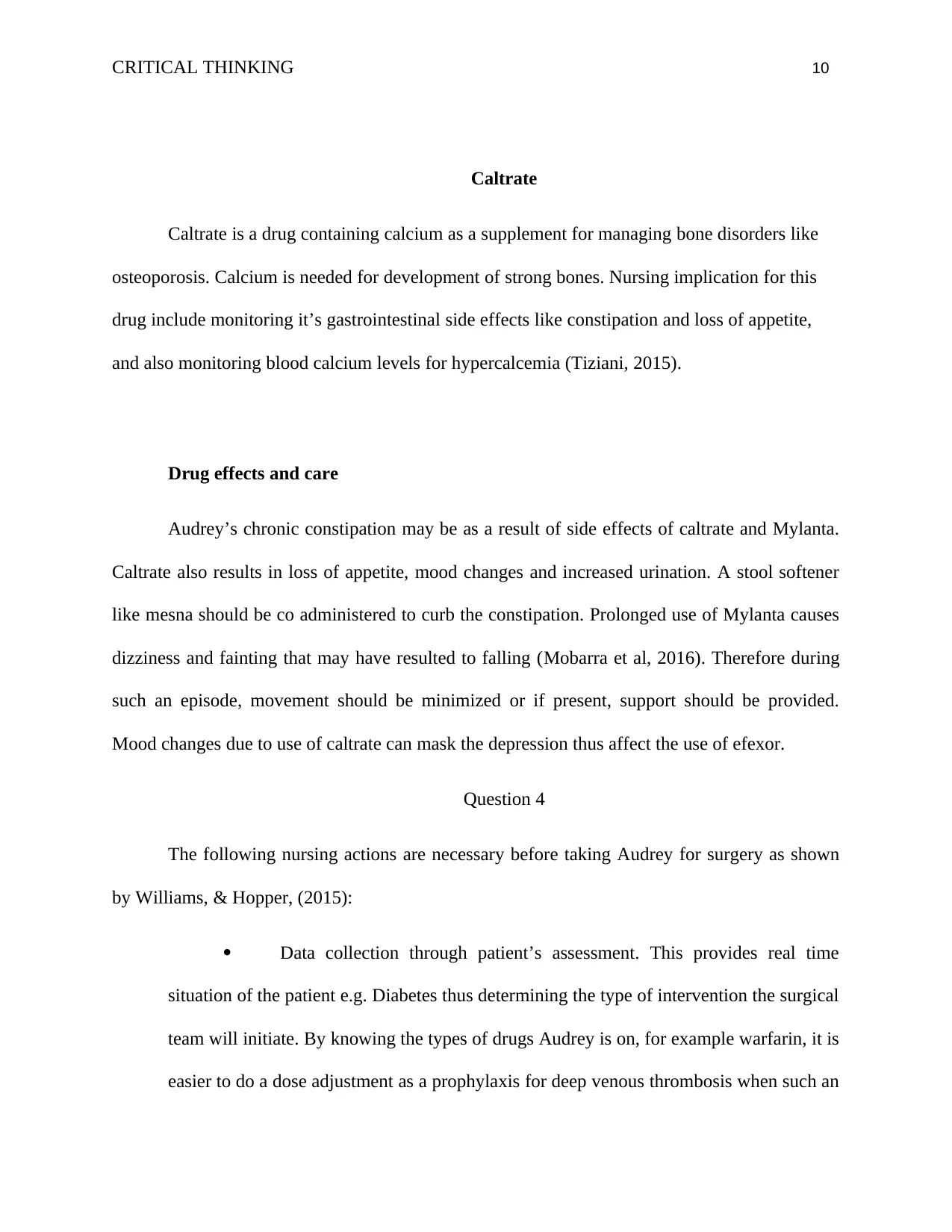
CRITICAL THINKING 10
Caltrate
Caltrate is a drug containing calcium as a supplement for managing bone disorders like
osteoporosis. Calcium is needed for development of strong bones. Nursing implication for this
drug include monitoring it’s gastrointestinal side effects like constipation and loss of appetite,
and also monitoring blood calcium levels for hypercalcemia (Tiziani, 2015).
Drug effects and care
Audrey’s chronic constipation may be as a result of side effects of caltrate and Mylanta.
Caltrate also results in loss of appetite, mood changes and increased urination. A stool softener
like mesna should be co administered to curb the constipation. Prolonged use of Mylanta causes
dizziness and fainting that may have resulted to falling (Mobarra et al, 2016). Therefore during
such an episode, movement should be minimized or if present, support should be provided.
Mood changes due to use of caltrate can mask the depression thus affect the use of efexor.
Question 4
The following nursing actions are necessary before taking Audrey for surgery as shown
by Williams, & Hopper, (2015):
Data collection through patient’s assessment. This provides real time
situation of the patient e.g. Diabetes thus determining the type of intervention the surgical
team will initiate. By knowing the types of drugs Audrey is on, for example warfarin, it is
easier to do a dose adjustment as a prophylaxis for deep venous thrombosis when such an
Caltrate
Caltrate is a drug containing calcium as a supplement for managing bone disorders like
osteoporosis. Calcium is needed for development of strong bones. Nursing implication for this
drug include monitoring it’s gastrointestinal side effects like constipation and loss of appetite,
and also monitoring blood calcium levels for hypercalcemia (Tiziani, 2015).
Drug effects and care
Audrey’s chronic constipation may be as a result of side effects of caltrate and Mylanta.
Caltrate also results in loss of appetite, mood changes and increased urination. A stool softener
like mesna should be co administered to curb the constipation. Prolonged use of Mylanta causes
dizziness and fainting that may have resulted to falling (Mobarra et al, 2016). Therefore during
such an episode, movement should be minimized or if present, support should be provided.
Mood changes due to use of caltrate can mask the depression thus affect the use of efexor.
Question 4
The following nursing actions are necessary before taking Audrey for surgery as shown
by Williams, & Hopper, (2015):
Data collection through patient’s assessment. This provides real time
situation of the patient e.g. Diabetes thus determining the type of intervention the surgical
team will initiate. By knowing the types of drugs Audrey is on, for example warfarin, it is
easier to do a dose adjustment as a prophylaxis for deep venous thrombosis when such an
Paraphrase This Document
Need a fresh take? Get an instant paraphrase of this document with our AI Paraphraser

CRITICAL THINKING 11
action is needed. Assessment of the overall patient condition will also determine whether
she is fit for surgery or not. (Williams, & Hopper, 2015)
Patient and family teaching. The patient and her family should be taken
through what the surgery involves, its advantages, possible risks and alternatives as a
prerequisite for consent. Autonomous consent is needed for better health care (Rincon
and Lee, 2015). The patient and the family is then able to understand the available
options, the procedure, its risks and other alternatives they can settle on. This is part of
ethics in medical practice, an integral part of patient and health care provider safety.
Planning for care for intraoperative and post-operative period like
monitoring vital signs and initiating antibiotic prophylaxis (Williams, & Hopper, 2015).
Communicating patient information to health care team to ascertain
whether it is safe to go in for surgery or not. Shared decisions in the health care sector
enhances wider view of available treatment options among other things (Gausvick et al,
2015)For example the nurse in charge should be able to share her decisions with the
surgeons, anesthetists and other people in the operating room regarding the underlying
conditions of Audrey like diabetes for better care.
Question 5
Patient from the surgical ward should be monitored closely by the nursing team.
The medical surgical nursing procedure by Williams, & Hopper, (2015) advocates for the
following list of interventions to be undertaken after Audrey is out of the operating
room.
Patient should be positioned as ordered by the doctor. If not fully
conscious, she should be placed in a side lying position (Williams, & Hopper, 2015).
action is needed. Assessment of the overall patient condition will also determine whether
she is fit for surgery or not. (Williams, & Hopper, 2015)
Patient and family teaching. The patient and her family should be taken
through what the surgery involves, its advantages, possible risks and alternatives as a
prerequisite for consent. Autonomous consent is needed for better health care (Rincon
and Lee, 2015). The patient and the family is then able to understand the available
options, the procedure, its risks and other alternatives they can settle on. This is part of
ethics in medical practice, an integral part of patient and health care provider safety.
Planning for care for intraoperative and post-operative period like
monitoring vital signs and initiating antibiotic prophylaxis (Williams, & Hopper, 2015).
Communicating patient information to health care team to ascertain
whether it is safe to go in for surgery or not. Shared decisions in the health care sector
enhances wider view of available treatment options among other things (Gausvick et al,
2015)For example the nurse in charge should be able to share her decisions with the
surgeons, anesthetists and other people in the operating room regarding the underlying
conditions of Audrey like diabetes for better care.
Question 5
Patient from the surgical ward should be monitored closely by the nursing team.
The medical surgical nursing procedure by Williams, & Hopper, (2015) advocates for the
following list of interventions to be undertaken after Audrey is out of the operating
room.
Patient should be positioned as ordered by the doctor. If not fully
conscious, she should be placed in a side lying position (Williams, & Hopper, 2015).

CRITICAL THINKING 12
The vital signs should be taken regularly and monitored as instructed.
Symptoms and complications should be watched out for at this stage (Williams, &
Hopper, 2015).
Assessing Audrey’s level of consciousness by looking at her reaction to
stimuli and ability to move the extremities. The patient should be helped in becoming
oriented by engaging in conversation (Williams, & Hopper, 2015).
Give intravenous fluids and monitor the input and output, correct amount
and intervals. Give medication as prescribed by the doctor (Williams, & Hopper, 2015).
Check the surgical wound, dressing and taking note of any color change,
odor, drainage and report to the supervisor in case of wound worsening (Williams, &
Hopper, 2015).
Assess indwelling catheters and suction from wound and drain them
appropriately. If there is oxygen mask in situ assess the flow rate and ensure optimal
delivery (Williams, & Hopper, 2015).
Comfort and assess the patient for pain and other complications of surgery
like the side effects of anesthesia that include vomiting and nausea. In case of pain at the
surgical site, the intensity, severity and duration. Prolonged or severe pain causes
psychological disturbance in a patient (Williams, & Hopper, 2015).
Question 6
Admitting a patient from one facility to another needs a multidisciplinary approach
(Cohen et al, 2015). Four nursing interventions that should be implemented by the nursing team
to prepare Audrey for a transition include:
The vital signs should be taken regularly and monitored as instructed.
Symptoms and complications should be watched out for at this stage (Williams, &
Hopper, 2015).
Assessing Audrey’s level of consciousness by looking at her reaction to
stimuli and ability to move the extremities. The patient should be helped in becoming
oriented by engaging in conversation (Williams, & Hopper, 2015).
Give intravenous fluids and monitor the input and output, correct amount
and intervals. Give medication as prescribed by the doctor (Williams, & Hopper, 2015).
Check the surgical wound, dressing and taking note of any color change,
odor, drainage and report to the supervisor in case of wound worsening (Williams, &
Hopper, 2015).
Assess indwelling catheters and suction from wound and drain them
appropriately. If there is oxygen mask in situ assess the flow rate and ensure optimal
delivery (Williams, & Hopper, 2015).
Comfort and assess the patient for pain and other complications of surgery
like the side effects of anesthesia that include vomiting and nausea. In case of pain at the
surgical site, the intensity, severity and duration. Prolonged or severe pain causes
psychological disturbance in a patient (Williams, & Hopper, 2015).
Question 6
Admitting a patient from one facility to another needs a multidisciplinary approach
(Cohen et al, 2015). Four nursing interventions that should be implemented by the nursing team
to prepare Audrey for a transition include:
⊘ This is a preview!⊘
Do you want full access?
Subscribe today to unlock all pages.

Trusted by 1+ million students worldwide

CRITICAL THINKING 13
Preparing the patient physically and psychologically. Audrey should be
physically stable before being transferred. The nursing team in conjunction with other
health care personnel in the hospital must ensure that she has recovered from her physical
illness of fractured bone, right side weakness, hypertension, atrial fibrillation and that her
blood sugar is well controlled. Psychological preparedness include lobbying for family
and community support for Audrey. This in addition to ensuring that there is adequate
psychiatric and other caregivers in the rehabilitation facility to holistically care for the
patient (Cohen et al, 2015).
Documenting Audrey’s past and current medical conditions. The salient
conditions like hypertension and drug allergies must be well documented so that incase of
any change in patient’s health condition in line to the past medical history, interventions
can be promptly done. Documentation is important in providing an insight of the patient
and giving a general picture of the type of patient the rehabilitation institution is
expecting (Rincon and Lee, 2015). Drugs that Audrey is under on should also be written
down with the correct dosage and timing. Such include the long term use drugs like
metformin, vitamin D and others in her drug list.
Educating the patient and family on need for admission to a rehabilitation
facility. The patient and family should be well informed of the procedure to be admitted
to another facility, the requirements, and options available and the importance of such a
decision. Doing such a procedure without the patient knowledge is not recommended in
practice as the patient should be part of their care (Cohen et al, 2015).
Engage the current hospital and the rehabilitation facility before admitting
Audrey. A multidisciplinary approach to patient care has been shown to improve patient
Preparing the patient physically and psychologically. Audrey should be
physically stable before being transferred. The nursing team in conjunction with other
health care personnel in the hospital must ensure that she has recovered from her physical
illness of fractured bone, right side weakness, hypertension, atrial fibrillation and that her
blood sugar is well controlled. Psychological preparedness include lobbying for family
and community support for Audrey. This in addition to ensuring that there is adequate
psychiatric and other caregivers in the rehabilitation facility to holistically care for the
patient (Cohen et al, 2015).
Documenting Audrey’s past and current medical conditions. The salient
conditions like hypertension and drug allergies must be well documented so that incase of
any change in patient’s health condition in line to the past medical history, interventions
can be promptly done. Documentation is important in providing an insight of the patient
and giving a general picture of the type of patient the rehabilitation institution is
expecting (Rincon and Lee, 2015). Drugs that Audrey is under on should also be written
down with the correct dosage and timing. Such include the long term use drugs like
metformin, vitamin D and others in her drug list.
Educating the patient and family on need for admission to a rehabilitation
facility. The patient and family should be well informed of the procedure to be admitted
to another facility, the requirements, and options available and the importance of such a
decision. Doing such a procedure without the patient knowledge is not recommended in
practice as the patient should be part of their care (Cohen et al, 2015).
Engage the current hospital and the rehabilitation facility before admitting
Audrey. A multidisciplinary approach to patient care has been shown to improve patient
Paraphrase This Document
Need a fresh take? Get an instant paraphrase of this document with our AI Paraphraser
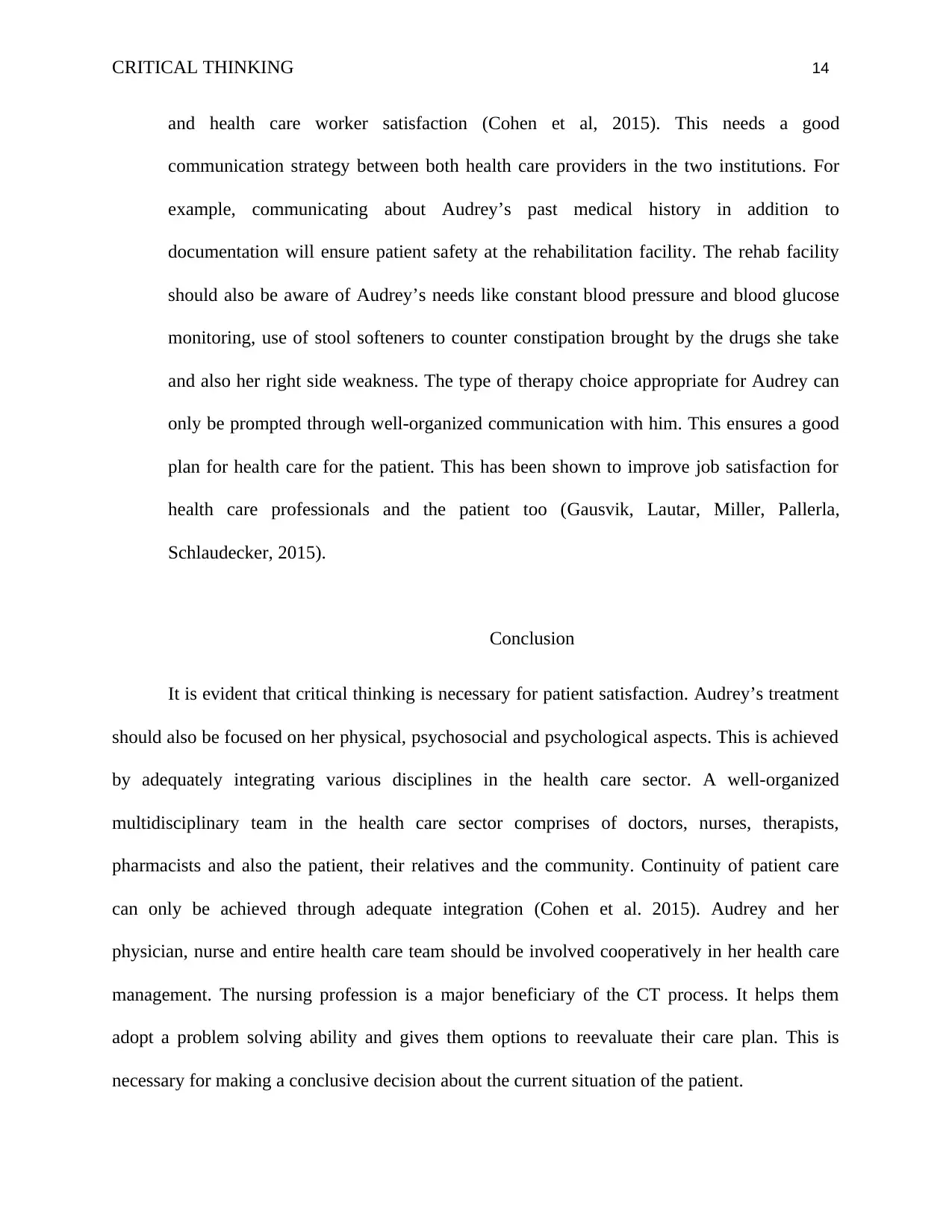
CRITICAL THINKING 14
and health care worker satisfaction (Cohen et al, 2015). This needs a good
communication strategy between both health care providers in the two institutions. For
example, communicating about Audrey’s past medical history in addition to
documentation will ensure patient safety at the rehabilitation facility. The rehab facility
should also be aware of Audrey’s needs like constant blood pressure and blood glucose
monitoring, use of stool softeners to counter constipation brought by the drugs she take
and also her right side weakness. The type of therapy choice appropriate for Audrey can
only be prompted through well-organized communication with him. This ensures a good
plan for health care for the patient. This has been shown to improve job satisfaction for
health care professionals and the patient too (Gausvik, Lautar, Miller, Pallerla,
Schlaudecker, 2015).
Conclusion
It is evident that critical thinking is necessary for patient satisfaction. Audrey’s treatment
should also be focused on her physical, psychosocial and psychological aspects. This is achieved
by adequately integrating various disciplines in the health care sector. A well-organized
multidisciplinary team in the health care sector comprises of doctors, nurses, therapists,
pharmacists and also the patient, their relatives and the community. Continuity of patient care
can only be achieved through adequate integration (Cohen et al. 2015). Audrey and her
physician, nurse and entire health care team should be involved cooperatively in her health care
management. The nursing profession is a major beneficiary of the CT process. It helps them
adopt a problem solving ability and gives them options to reevaluate their care plan. This is
necessary for making a conclusive decision about the current situation of the patient.
and health care worker satisfaction (Cohen et al, 2015). This needs a good
communication strategy between both health care providers in the two institutions. For
example, communicating about Audrey’s past medical history in addition to
documentation will ensure patient safety at the rehabilitation facility. The rehab facility
should also be aware of Audrey’s needs like constant blood pressure and blood glucose
monitoring, use of stool softeners to counter constipation brought by the drugs she take
and also her right side weakness. The type of therapy choice appropriate for Audrey can
only be prompted through well-organized communication with him. This ensures a good
plan for health care for the patient. This has been shown to improve job satisfaction for
health care professionals and the patient too (Gausvik, Lautar, Miller, Pallerla,
Schlaudecker, 2015).
Conclusion
It is evident that critical thinking is necessary for patient satisfaction. Audrey’s treatment
should also be focused on her physical, psychosocial and psychological aspects. This is achieved
by adequately integrating various disciplines in the health care sector. A well-organized
multidisciplinary team in the health care sector comprises of doctors, nurses, therapists,
pharmacists and also the patient, their relatives and the community. Continuity of patient care
can only be achieved through adequate integration (Cohen et al. 2015). Audrey and her
physician, nurse and entire health care team should be involved cooperatively in her health care
management. The nursing profession is a major beneficiary of the CT process. It helps them
adopt a problem solving ability and gives them options to reevaluate their care plan. This is
necessary for making a conclusive decision about the current situation of the patient.

CRITICAL THINKING 15
References
Ahn, E., Lee, J., Park, Y. S., Noh, H. M., & Kim, B. H. (2015). Association between delivery at
an advanced maternal age and osteoporosis in elderly Korean women. Journal of bone
and mineral metabolism, 33(6), 666-673.
Bernabé-Ortiz, A., Carrillo-Larco, R. M., Gilman, R. H., Checkley, W., Smeeth, L., Miranda, J.
J., & CRONICAS Cohort Study Group. (2016). Contribution of modifiable risk factors
for hypertension and type-2 diabetes in Peruvian resource-limited settings. J Epidemiol
Community Health, 70(1), 49-55.
Chiauzzi, E., Rodarte, C., & DasMahapatra, P. (2015). Patient-centered activity monitoring in
the self-management of chronic health conditions. BMC medicine, 13(1), 77.
Cho, E., Chin, D. L., Kim, S., & Hong, O. (2016). The relationships of nurse staffing level and
work environment with patient adverse events. Journal of Nursing Scholarship, 48(1),
74-82.
Feo, R., & Kitson, A. (2016). Promoting patient-centred fundamental care in acute healthcare
systems. International journal of nursing studies, 57, 1-11.
Gausvik, C., Lautar, A., Miller, L., Pallerla, H., & Schlaudecker, J. (2015). Structured nursing
communication on interdisciplinary acute care teams improves perceptions of safety,
efficiency, understanding of care plan and teamwork as well as job satisfaction. Journal
of multidisciplinary healthcare, 8, 33.
References
Ahn, E., Lee, J., Park, Y. S., Noh, H. M., & Kim, B. H. (2015). Association between delivery at
an advanced maternal age and osteoporosis in elderly Korean women. Journal of bone
and mineral metabolism, 33(6), 666-673.
Bernabé-Ortiz, A., Carrillo-Larco, R. M., Gilman, R. H., Checkley, W., Smeeth, L., Miranda, J.
J., & CRONICAS Cohort Study Group. (2016). Contribution of modifiable risk factors
for hypertension and type-2 diabetes in Peruvian resource-limited settings. J Epidemiol
Community Health, 70(1), 49-55.
Chiauzzi, E., Rodarte, C., & DasMahapatra, P. (2015). Patient-centered activity monitoring in
the self-management of chronic health conditions. BMC medicine, 13(1), 77.
Cho, E., Chin, D. L., Kim, S., & Hong, O. (2016). The relationships of nurse staffing level and
work environment with patient adverse events. Journal of Nursing Scholarship, 48(1),
74-82.
Feo, R., & Kitson, A. (2016). Promoting patient-centred fundamental care in acute healthcare
systems. International journal of nursing studies, 57, 1-11.
Gausvik, C., Lautar, A., Miller, L., Pallerla, H., & Schlaudecker, J. (2015). Structured nursing
communication on interdisciplinary acute care teams improves perceptions of safety,
efficiency, understanding of care plan and teamwork as well as job satisfaction. Journal
of multidisciplinary healthcare, 8, 33.
⊘ This is a preview!⊘
Do you want full access?
Subscribe today to unlock all pages.

Trusted by 1+ million students worldwide

CRITICAL THINKING 16
KUMAR, D. N. R., Gandhi, M. V. V., & Harsha, G. S. (2016). GERD CORRELATION
BETWEEN CLINICAL SYMPTOMS AND ENDOSCOPIC FINDINGS-STUDY IN
200 PATIENTS. Dysphagia, 4, 2.
Lomonaco, T., Ghimenti, S., Piga, I., Biagini, D., Onor, M., Fuoco, R., ... & Di Francesco, F.
(2018). Monitoring of warfarin therapy: Preliminary results from a longitudinal pilot
study. Microchemical Journal, 136, 170-176.
Mehra, A. (2014). Hysterectomy-" Anger against the Womb" A Psychological Perspective.
Implications for Services. Gynecol Obstet (Sunnyvale), 4(255), 2161-0932.
Mobarra, N., Shanaki, M., Ehteram, H., Nasiri, H., Sahmani, M., Saeidi, M., ... & Azad, M.
(2016). A review on iron chelators in treatment of iron overload syndromes.
International journal of hematology-oncology and stem cell research, 10(4), 239.
O'Donnell, M. J., Chin, S. L., Rangarajan, S., Xavier, D., Liu, L., Zhang, H., ... & Lopez-
Jaramillo, P. (2016). Global and regional effects of potentially modifiable risk factors
associated with acute stroke in 32 countries (INTERSTROKE): a case-control study. The
Lancet, 388(10046), 761-775.
Pipaliya, N., Solanke, D., Rathi, C., Patel, R., Ingle, M., & Sawant, P. (2016). Esomeprazole
induced galactorrhea: a novel side effect. Clinical journal of gastroenterology, 9(1), 13-
16.
Preiser, J. C., van Zanten, A. R., Berger, M. M., Biolo, G., Casaer, M. P., Doig, G. S., ... &
Laviano, A. (2015). Metabolic and nutritional support of critically ill patients: consensus
and controversies. Critical care, 19(1), 35.
KUMAR, D. N. R., Gandhi, M. V. V., & Harsha, G. S. (2016). GERD CORRELATION
BETWEEN CLINICAL SYMPTOMS AND ENDOSCOPIC FINDINGS-STUDY IN
200 PATIENTS. Dysphagia, 4, 2.
Lomonaco, T., Ghimenti, S., Piga, I., Biagini, D., Onor, M., Fuoco, R., ... & Di Francesco, F.
(2018). Monitoring of warfarin therapy: Preliminary results from a longitudinal pilot
study. Microchemical Journal, 136, 170-176.
Mehra, A. (2014). Hysterectomy-" Anger against the Womb" A Psychological Perspective.
Implications for Services. Gynecol Obstet (Sunnyvale), 4(255), 2161-0932.
Mobarra, N., Shanaki, M., Ehteram, H., Nasiri, H., Sahmani, M., Saeidi, M., ... & Azad, M.
(2016). A review on iron chelators in treatment of iron overload syndromes.
International journal of hematology-oncology and stem cell research, 10(4), 239.
O'Donnell, M. J., Chin, S. L., Rangarajan, S., Xavier, D., Liu, L., Zhang, H., ... & Lopez-
Jaramillo, P. (2016). Global and regional effects of potentially modifiable risk factors
associated with acute stroke in 32 countries (INTERSTROKE): a case-control study. The
Lancet, 388(10046), 761-775.
Pipaliya, N., Solanke, D., Rathi, C., Patel, R., Ingle, M., & Sawant, P. (2016). Esomeprazole
induced galactorrhea: a novel side effect. Clinical journal of gastroenterology, 9(1), 13-
16.
Preiser, J. C., van Zanten, A. R., Berger, M. M., Biolo, G., Casaer, M. P., Doig, G. S., ... &
Laviano, A. (2015). Metabolic and nutritional support of critically ill patients: consensus
and controversies. Critical care, 19(1), 35.
Paraphrase This Document
Need a fresh take? Get an instant paraphrase of this document with our AI Paraphraser
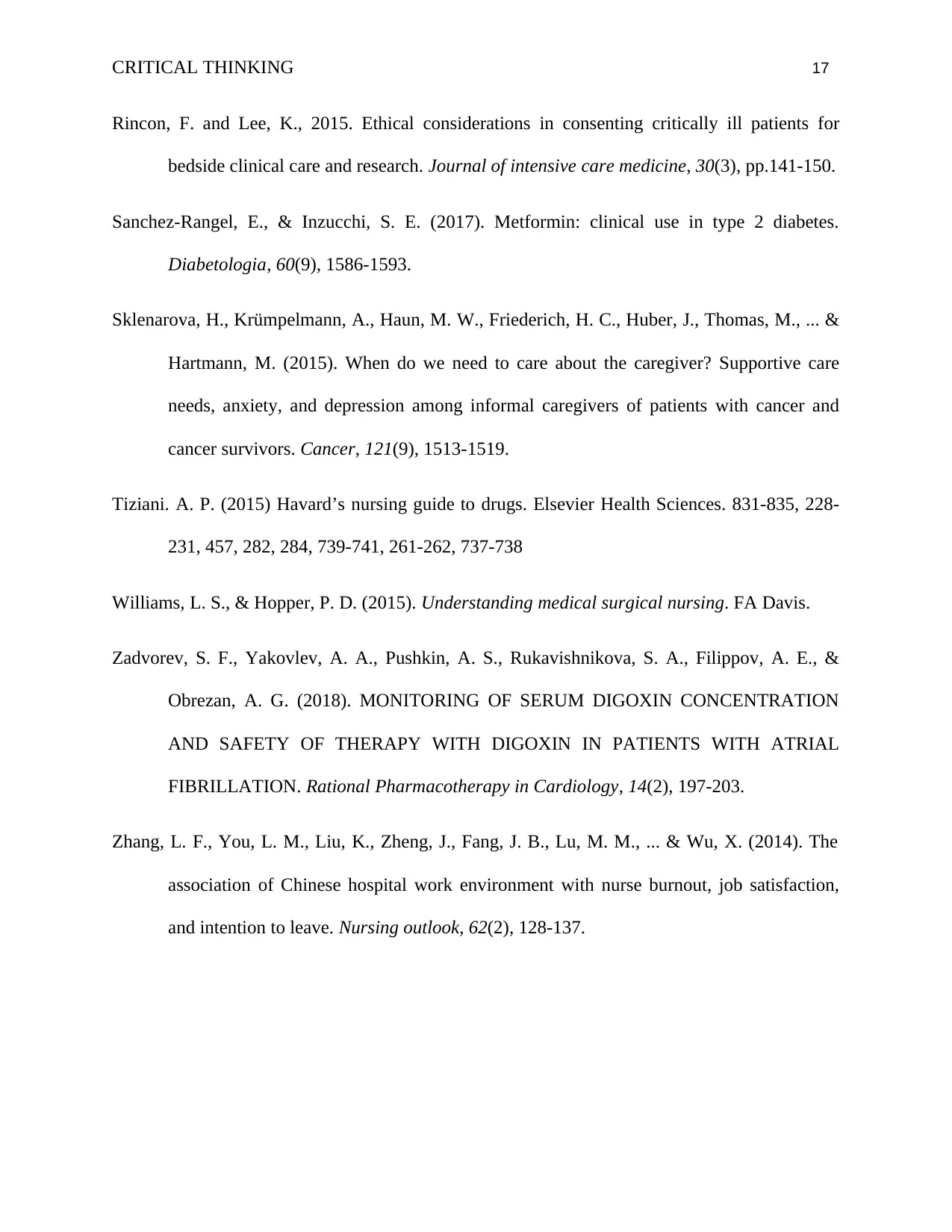
CRITICAL THINKING 17
Rincon, F. and Lee, K., 2015. Ethical considerations in consenting critically ill patients for
bedside clinical care and research. Journal of intensive care medicine, 30(3), pp.141-150.
Sanchez-Rangel, E., & Inzucchi, S. E. (2017). Metformin: clinical use in type 2 diabetes.
Diabetologia, 60(9), 1586-1593.
Sklenarova, H., Krümpelmann, A., Haun, M. W., Friederich, H. C., Huber, J., Thomas, M., ... &
Hartmann, M. (2015). When do we need to care about the caregiver? Supportive care
needs, anxiety, and depression among informal caregivers of patients with cancer and
cancer survivors. Cancer, 121(9), 1513-1519.
Tiziani. A. P. (2015) Havard’s nursing guide to drugs. Elsevier Health Sciences. 831-835, 228-
231, 457, 282, 284, 739-741, 261-262, 737-738
Williams, L. S., & Hopper, P. D. (2015). Understanding medical surgical nursing. FA Davis.
Zadvorev, S. F., Yakovlev, A. A., Pushkin, A. S., Rukavishnikova, S. A., Filippov, A. E., &
Obrezan, A. G. (2018). MONITORING OF SERUM DIGOXIN CONCENTRATION
AND SAFETY OF THERAPY WITH DIGOXIN IN PATIENTS WITH ATRIAL
FIBRILLATION. Rational Pharmacotherapy in Cardiology, 14(2), 197-203.
Zhang, L. F., You, L. M., Liu, K., Zheng, J., Fang, J. B., Lu, M. M., ... & Wu, X. (2014). The
association of Chinese hospital work environment with nurse burnout, job satisfaction,
and intention to leave. Nursing outlook, 62(2), 128-137.
Rincon, F. and Lee, K., 2015. Ethical considerations in consenting critically ill patients for
bedside clinical care and research. Journal of intensive care medicine, 30(3), pp.141-150.
Sanchez-Rangel, E., & Inzucchi, S. E. (2017). Metformin: clinical use in type 2 diabetes.
Diabetologia, 60(9), 1586-1593.
Sklenarova, H., Krümpelmann, A., Haun, M. W., Friederich, H. C., Huber, J., Thomas, M., ... &
Hartmann, M. (2015). When do we need to care about the caregiver? Supportive care
needs, anxiety, and depression among informal caregivers of patients with cancer and
cancer survivors. Cancer, 121(9), 1513-1519.
Tiziani. A. P. (2015) Havard’s nursing guide to drugs. Elsevier Health Sciences. 831-835, 228-
231, 457, 282, 284, 739-741, 261-262, 737-738
Williams, L. S., & Hopper, P. D. (2015). Understanding medical surgical nursing. FA Davis.
Zadvorev, S. F., Yakovlev, A. A., Pushkin, A. S., Rukavishnikova, S. A., Filippov, A. E., &
Obrezan, A. G. (2018). MONITORING OF SERUM DIGOXIN CONCENTRATION
AND SAFETY OF THERAPY WITH DIGOXIN IN PATIENTS WITH ATRIAL
FIBRILLATION. Rational Pharmacotherapy in Cardiology, 14(2), 197-203.
Zhang, L. F., You, L. M., Liu, K., Zheng, J., Fang, J. B., Lu, M. M., ... & Wu, X. (2014). The
association of Chinese hospital work environment with nurse burnout, job satisfaction,
and intention to leave. Nursing outlook, 62(2), 128-137.
1 out of 17
Related Documents
Your All-in-One AI-Powered Toolkit for Academic Success.
+13062052269
info@desklib.com
Available 24*7 on WhatsApp / Email
![[object Object]](/_next/static/media/star-bottom.7253800d.svg)
Unlock your academic potential
© 2024 | Zucol Services PVT LTD | All rights reserved.




